Content marketing is one of the most effective ways to connect with your audience and achieve your business objectives. But starting without clear goals and an understanding of your audience is like navigating without a map. At EagleGravity, we’ve seen how defining goals and identifying your audience can transform content strategies into success stories. Let’s delve into this essential first step and make your content marketing journey purposeful and impactful.
Step 1 : Setting Clear Goals: Your North Star
Establishing content marketing goals is the first and most critical step. Without clear goals, it’s impossible to measure success, adapt strategies, or ensure your efforts align with your business objectives. Imagine planning a road trip. Would you start driving without knowing your destination? Of course not. Similarly, content marketing goals act as your roadmap.
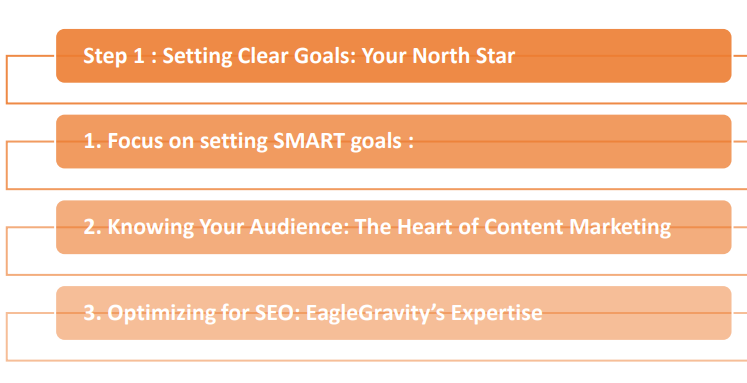
1. Focus on setting SMART goals :
– Specific : Clearly define what you want to achieve (e.g., gain 20% more website visitors).
– Measurable : Use analytics to track progress (e.g., social shares, newsletter signups).
– Achievable : Base your goals on realistic expectations and available resources.
– Relevant : Align your content goals with your broader business objectives.
– Time-bound : Set deadlines to maintain momentum and focus.
For instance, a common goal might be to increase organic traffic by publishing SEO-optimized blog posts or to build brand authority by creating high-quality, expert content.
2. Knowing Your Audience: The Heart of Content Marketing
Understanding your audience ensures your content is relevant and engaging. Imagine throwing a party without knowing your guests. You’d risk offering food or music they dislike. Similarly, content marketing without audience insights can lead to irrelevant messaging.
Start with these key questions:
– Who are they? Define demographics like age, location, and profession.
– What are their challenges? Understand their pain points and problems.
– Where do they consume content? Identify platforms and formats they prefer.
– Why will they care? Determine the value they seek from your content.
At EagleGravity, we recommend creating buyer personas to humanize your audience. For example:
– Persona Name: Tech-Savvy Tina
– Age: 35
– Profession: Marketing Manager
– Challenges: Staying updated on digital trends without feeling overwhelmed
– Goals: Implementing effective strategies for her team
These personas help you tailor content to resonate deeply with your audience’s needs.
3. Optimizing for SEO: EagleGravity’s Expertise
To ensure your content reaches your audience, optimize it for search engines. Use focus keywords like “content marketing goals,” “defining audience,” and “how to create buyer personas” in the first 10% of your content and naturally throughout. At EagleGravity, we prioritize SEO best practices, ensuring your content ranks higher and gets noticed.
Key Insights for Success
– Define clear, SMART goals to guide your content marketing.
– Understand your audience’s needs, preferences, and challenges.
– Use SEO strategies to maximize visibility and impact.
By following these steps, you’ll lay a strong foundation for a content marketing strategy that not only aligns with your vision but also delivers measurable results. Let EagleGravity help you take the first step toward content marketing success!
Step 2: Conducting Market and Competitor Analysis: The Next Crucial Step
Once you have defined your goals and audience, the next step is conducting a thorough market and competitor analysis. This step is essential to identify opportunities, understand industry trends, and gain a competitive edge. At EagleGravity, we’ve seen businesses thrive by leveraging insights from this critical process.
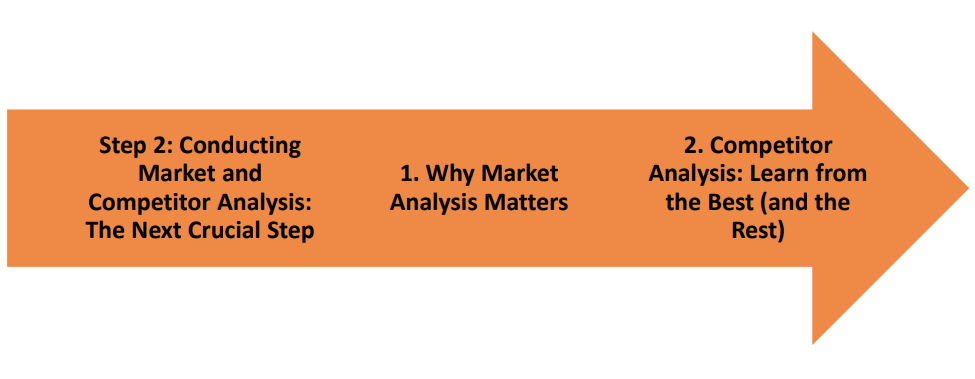
1. Why Market Analysis Matters
Market analysis helps you uncover trends, customer preferences, and potential gaps in the market. Think of it like going shopping for a new car. You wouldn’t make a purchase without researching the best models, features, and prices. Similarly, analyzing your market gives you a clear picture of what’s working and where you can stand out.
Steps to Conduct Effective Market Analysis
Research Industry Trends: Stay updated on what’s happening in your industry. Use tools like Google Trends or industry reports to identify popular topics and emerging demands.
Understand Your Niche: Pinpoint what makes your business unique and how it aligns with audience needs. For example, are you catering to budget-conscious shoppers or luxury buyers?
Evaluate Customer Behavior: Look at what your audience is searching for online. Tools like Google Analytics and social media insights can reveal valuable data about preferences and engagement patterns.
2. Competitor Analysis: Learn from the Best (and the Rest)
Competitor analysis is your chance to understand what’s working for others and where they’re falling short. Imagine opening a café in a neighborhood with several coffee shops. You’d first observe their pricing, menu, and customer service to identify what you could do better. The same principle applies here.
Steps to Analyze Competitors
Identify Key Competitors: List your top competitors in the industry. Tools like SEMrush and Ahrefs can help you discover who ranks for your target keywords.
Audit Their Content: Study their blogs, videos, and social media posts. What topics are they covering? What formats are they using? Look for content gaps you can fill.
Evaluate Their SEO Strategies: Analyze keyword usage, backlink profiles, and website structure. Identify opportunities to improve your own SEO.
Assess Engagement: Look at how their audience interacts with their content. Are they getting comments, shares, and likes? Understanding this can guide your engagement strategies.
Step 3: Developing a Content Strategy: A Blueprint for Success
Creating a robust content strategy is the cornerstone of successful content marketing. Without a clear plan, your efforts can become scattered, failing to deliver the results you desire. At EagleGravity, we emphasize the importance of developing a content strategy that aligns with your business goals and resonates with your audience. Let’s explore this crucial process, blending practical steps with real-life experiences to illustrate its impact.
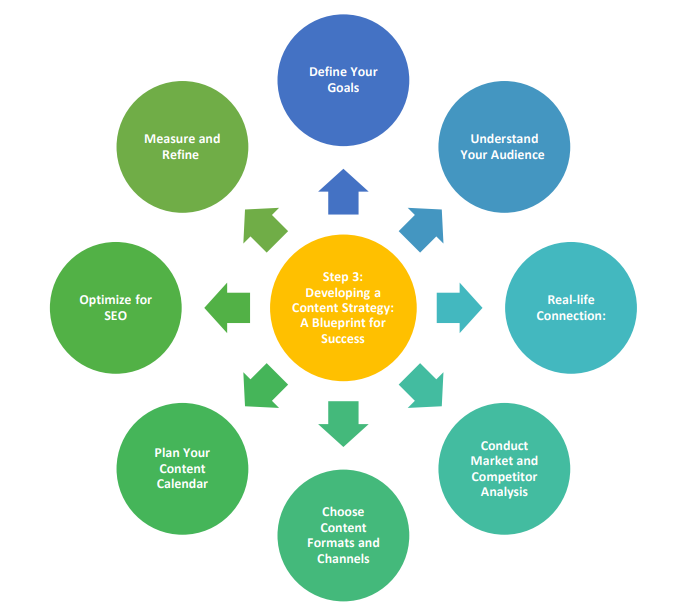
Why a Content Strategy is Essential
Imagine trying to build a house without a blueprint. You might end up with a structure that’s unstable or doesn’t meet your needs. A content strategy is like that blueprint – it ensures your efforts are purposeful, cohesive, and designed to achieve your objectives. Whether your goal is to increase website traffic, improve engagement, or drive conversions, a well-crafted strategy provides the roadmap to get there.
Key Steps to Develop a Winning Content Strategy
Define Your Goals Your content strategy starts with clear, actionable goals. Ask yourself: What do you want to achieve with your content? Whether it’s increasing organic traffic, building brand authority, or generating leads, ensure your goals are SMART: Specific, Measurable, Achievable, Relevant, and Time-bound.
Example: At EagleGravity, one of our clients aimed to increase their blog traffic by 50% within six months. We crafted a strategy focused on SEO-optimized, high-value content tailored to their audience.
Understand Your Audience Content that resonates begins with a deep understanding of your audience. Create detailed buyer personas that include demographics, preferences, challenges, and goals. Use tools like Google Analytics and social media insights to gather data about your audience’s behavior and interests.
Real-life Connection: Imagine you’re a fitness coach targeting busy professionals. Your persona might be “Workout Warrior Will,” a 30-year-old marketing manager seeking quick, effective workouts. Crafting content like “10-Minute Workouts for Busy Professionals” directly addresses his needs.
Conduct Market and Competitor Analysis A strong strategy is informed by a thorough understanding of your market and competitors. Identify content gaps, trends, and opportunities. Tools like SEMrush, Ahrefs, and BuzzSumo can help you uncover what’s working for your competitors and where you can differentiate.
Choose Content Formats and Channels Not all content types work for every audience. Based on your research, decide on the formats (blogs, videos, infographics, etc.) and channels (social media, email, website) that align with your goals and audience preferences. Diversify your content to cater to different consumption habits.
Plan Your Content Calendar Consistency is key to building trust and engagement. Develop a content calendar that outlines your publishing schedule, topics, and formats. At EagleGravity, we recommend planning at least three months ahead to maintain a steady flow of content while leaving room for adjustments.
Optimize for SEO Search engine optimization is vital for ensuring your content reaches your audience. Use focus keywords like “developing a content strategy,” “how to create a content plan,” and “effective content marketing” in the first 10% of your content and naturally throughout. Include meta descriptions, headers, and internal links to boost visibility.
Measure and Refine No strategy is complete without regular evaluation. Use analytics tools to track performance against your goals. Identify what’s working, what’s not, and refine your approach accordingly. Continuous improvement is the hallmark of successful content marketing.
Real-Life Example: From Chaos to Clarity
Consider Lisa, a small business owner struggling to attract traffic to her e-commerce store. With help from EagleGravity, she developed a content strategy focusing on product tutorials and customer success stories. By optimizing her content for SEO and sharing it on social media, Lisa saw a 60% increase in website visits within three months. The clear strategy transformed her efforts from guesswork to measurable success.
Why Choose EagleGravity?
At EagleGravity, we specialize in crafting tailored content strategies that drive results. By combining market insights, creative storytelling, and SEO expertise, we help businesses like yours stand out in a crowded digital landscape. Let us guide you every step of the way, from setting goals to measuring success.
Key Takeaways for Developing a Content Strategy
Set clear, SMART goals to guide your efforts.
Understand your audience through detailed personas and analytics.
Conduct thorough market and competitor analysis to uncover opportunities.
Choose formats and channels that align with your audience’s preferences.
Optimize for SEO to maximize reach and impact.
Evaluate and refine your strategy based on performance data.
By following these steps, you’ll create a content strategy that not only aligns with your goals but also delivers tangible results. Start building your content marketing blueprint with EagleGravity today!
Step 4: Creating a Content Calendar: The Foundation of Consistent Content Marketing
In content marketing, consistency is the key to building trust, engagement, and long-term success. The first step to ensuring consistency is creating a well-structured content calendar. At EagleGravity, we’ve guided businesses to success by helping them implement content calendars that align with their goals and audience needs. Let’s explore how this essential tool can streamline your content marketing efforts and maximize your impact.
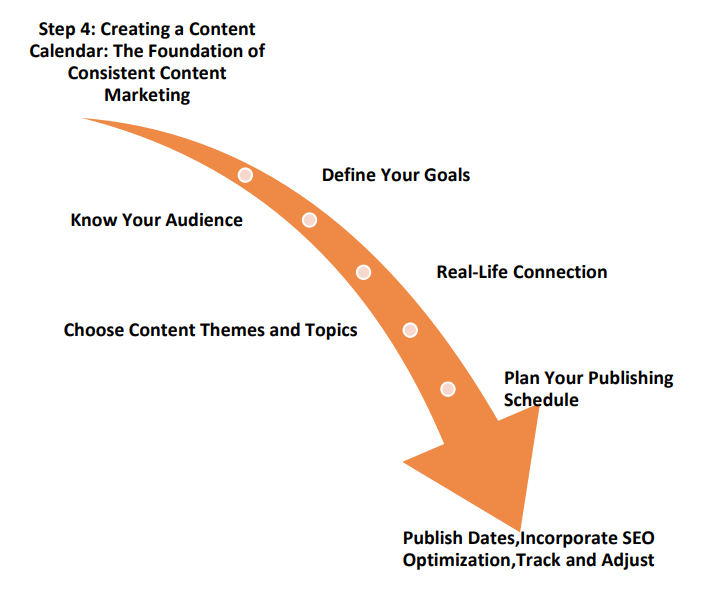
Why a Content Calendar is Essential
Imagine planning a family vacation without an itinerary. You’d likely miss key attractions, waste time, or overspend. A content calendar serves as your itinerary for content marketing. It helps you plan, organize, and execute your strategy efficiently while staying aligned with your goals.
By creating a content calendar, Maintain consistency in publishing.
Align content with business objectives and seasonal trends.
Avoid last-minute scrambling for ideas.
Track performance and adjust strategies as needed.
Steps to Create an Effective Content Calendar
Define Your Goals Before diving into content planning, clarify what you want to achieve. Are you aiming to increase website traffic, boost social media engagement, or drive sales? Clear goals will guide the type of content you create and where you publish it.
Example: At EagleGravity, a client wanted to increase blog traffic by 30% in six months. We developed a content calendar focused on weekly SEO-optimized posts targeting their audience’s pain points.
Know Your Audience Understanding your audience is critical for creating relevant content. Use analytics tools to identify their preferences, challenges, and the platforms they frequent. Align your content topics and formats with these insights.
Real-Life Connection: Imagine you’re a travel blogger targeting budget travelers. Your audience might look for “Top 10 Affordable Destinations” or “How to Save on Flights.” A content calendar ensures you regularly deliver such valuable posts.
Choose Content Themes and Topics Outline themes that resonate with your audience and align with your goals. Break these themes into specific topics that address their needs. For example:
Theme: Healthy Living
Topics: “10-Minute Workouts for Beginners,” “Meal Prep Ideas for Busy Professionals.”
Decide on Content Formats and Channels Not all audiences consume content the same way. Determine whether blogs, videos, infographics, or podcasts are most effective. Then, choose the platforms (e.g., your website, Instagram, YouTube) where your audience is most active.
Plan Your Publishing Schedule Use your content calendar to schedule posts consistently. Include:
Publish Dates: When each piece of content will go live.
Content Type: Blog, video, infographic, etc.
Platform: The channel where it will be published.
Keywords: Focus keywords like “creating a content calendar,” “content marketing plan,” and “how to schedule content.”
Pro Tip: At EagleGravity, we recommend posting evergreen content regularly while interspersing timely, trending topics to keep your audience engaged.
Incorporate SEO Optimization Your content calendar should include SEO strategies for each piece. Plan target keywords, meta descriptions, and internal linking opportunities. For example, if your focus is on “creating a content calendar,” ensure it appears prominently in titles, headers, and throughout the content naturally.
Track and Adjust A content calendar isn’t static. Monitor the performance of your content and adjust your calendar based on analytics. For instance, if a specific topic performs exceptionally well, consider creating more content around that theme.
Tools to Build Your Content Calendar
Several tools can simplify the process of creating and managing your content calendar:
Google Sheets: A flexible, free option for tracking schedules.
Trello or Asana: Great for team collaboration and tracking tasks.
ContentStudio or CoSchedule: Comprehensive tools for scheduling and analytics.
Step 5. How to Create Content That Boosts Results in a Short Time
In the fast-paced world of content marketing, creating impactful content that delivers quick results can be a game-changer. At EagleGravity, we specialize in strategies that help businesses achieve rapid growth through smart content creation. Whether your goal is to increase traffic, engagement, or conversions, understanding how to craft high-performing content is crucial. Let’s explore proven techniques to create content that generates a boost in a short time.
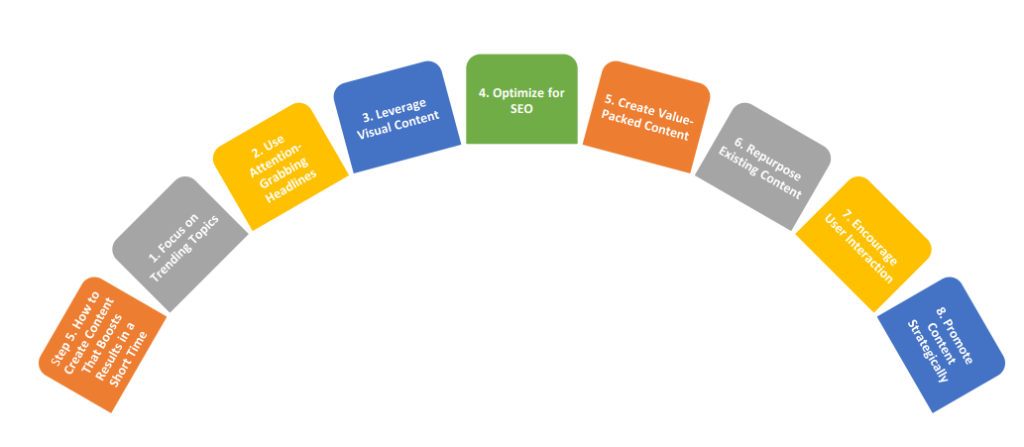
Why Quick-Impact Content Matters
Imagine hosting a surprise party for a friend with little time to prepare. You’d focus on key elements like inviting close friends, choosing a meaningful theme, and ensuring their favorite treats are ready. Similarly, quick-impact content focuses on high-priority actions that drive immediate results. It’s about identifying what resonates most with your audience and delivering value right away.
Steps to Create Content That Boosts Results
1. Focus on Trending Topics
Capitalize on current trends and hot topics in your industry. Use tools like Google Trends, Twitter hashtags, or BuzzSumo to identify what’s gaining traction. Trending topics naturally attract higher search volumes and engagement.
*Example:* A fitness blogger might quickly create a post like “5 Simple Exercises to Start Your New Year’s Fitness Journey” during January when fitness resolutions are popular.
2. Use Attention-Grabbing Headlines
Your headline is the first thing your audience sees, and it determines whether they’ll click through. Craft compelling, SEO-optimized headlines that promise value or solve a problem. Include focus keywords like “how to create content that boosts,” “quick content marketing tips,” and “high-performing content creation.”
Pro Tip: Headlines like “10 Strategies to Boost Website Traffic in 24 Hours” or “How to Go Viral with Simple Content” instantly pique interest.
3. Leverage Visual Content
Visuals such as infographics, short videos, and carousel posts are highly engaging and shareable. They convey information quickly, making them ideal for time-sensitive campaigns. Platforms like Instagram, Pinterest, and TikTok thrive on visual content that grabs attention.
4. Optimize for SEO
Ensure your content ranks quickly by incorporating SEO best practices. Use tools like SEMrush or Ahrefs to identify focus keywords, and integrate them naturally into:
– Titles and headlines.
– Meta descriptions.
– Subheadings.
– Image alt texts.
At EagleGravity, we’ve seen clients achieve significant traffic boosts by optimizing their content for high-value, low-competition keywords.
5. Create Value-Packed Content
Even short-form content should deliver maximum value. Address your audience’s pain points, answer questions, or provide actionable tips. This builds trust and encourages sharing.
Real-Life Connection: Think of a busy parent looking for quick meal ideas. A blog post titled “5 Healthy Dinners Ready in Under 20 Minutes” delivers exactly what they need, increasing the likelihood of engagement and sharing.
6. Repurpose Existing Content
Maximize efficiency by repurposing high-performing content into new formats. For example:
– Turn a popular blog post into a video.
– Create an infographic summarizing key points.
– Share bite-sized tips from a longer guide on social media.
7. Encourage User Interaction
Boost engagement by involving your audience. Use polls, quizzes, or ask questions in your content to encourage participation. User-generated content, such as reviews or testimonials, also enhances credibility and reach.
8. Promote Content Strategically
Content promotion is just as important as creation. Share your content across multiple platforms, including social media, email newsletters, and niche communities. Collaborate with influencers or leverage paid ads to amplify reach.
Example: A small business owner might use Instagram ads to promote a time-limited offer blog post, driving immediate traffic.
Step 6:How to Distribute and Promote Content in Various Ways
Creating high-quality content is just the first step in content marketing. To ensure your content reaches the right audience and delivers maximum impact, a strategic approach to distribution and promotion is essential. At EagleGravity, we understand that even the most engaging content needs the right channels and strategies to succeed. Let’s explore actionable ways to distribute and promote your content effectively, ensuring it resonates with your audience and achieves your marketing goals.

Why Content Distribution Matters
Imagine you’ve cooked a delicious meal but kept it hidden in your kitchen. Without serving it, no one gets to enjoy the fruits of your labor. Similarly, content that isn’t distributed and promoted remains unseen and unappreciated. Content distribution ensures your message reaches your target audience, driving traffic, engagement, and conversions.
Steps to Distribute and Promote Content Effectively
1. Leverage Social Media Platforms
Social media is one of the most effective channels for content distribution. Choose platforms where your audience is most active, such as Facebook, Instagram, LinkedIn, or Twitter. Customize your content to fit each platform’s unique features:
– Use engaging visuals and captions on Instagram.
– Share professional insights and articles on LinkedIn.
– Post conversational and timely updates on Twitter.
Example: A fashion brand might share a behind-the-scenes video of a photoshoot on Instagram, accompanied by a blog post link about the latest fashion trends.
2. Build an Email Marketing Campaign
Email remains a powerful tool for content promotion. Create segmented email lists based on audience preferences and share tailored content. Use enticing subject lines and include clear calls-to-action (CTAs) to encourage clicks.
Pro Tip: At EagleGravity, we recommend creating a weekly newsletter that highlights your latest blogs, videos, or offers. This keeps your audience engaged and informed.
3. Collaborate with Influencers
Partnering with influencers in your niche can amplify your content’s reach. Influencers have established trust with their audience, making their recommendations highly impactful. Provide them with shareable content, such as product reviews or sponsored posts, to expand your visibility.
4. Repurpose Content for Different Channels
Maximize your content’s value by repurposing it into different formats:
– Turn a blog post into a series of social media posts.
– Convert a webinar into short video clips for YouTube or Instagram.
– Transform data-heavy articles into infographics for Pinterest.
This approach ensures your content reaches diverse audiences in their preferred formats.
5. Engage in Online Communities and Forums
Participate in niche-specific forums, Facebook groups, or Reddit communities. Share your content as a solution to common questions or problems discussed in these spaces. Be mindful of community guidelines and avoid overt self-promotion.
*Real-Life Connection:* Think of a tech blogger sharing a detailed guide on troubleshooting software issues in a Reddit thread. This positions them as an expert and drives traffic to their blog.
6. Invest in Paid Advertising
Boost your content’s visibility with paid ads on platforms like Google, Facebook, or Instagram. Target your audience based on demographics, interests, and behaviors to ensure your content reaches the right people.
Example: A small business owner promoting an eBook might run a Facebook ad targeting entrepreneurs interested in productivity tips.
7. Utilize Content Syndication Platforms
Syndication platforms like Medium, LinkedIn Articles, and Outbrain allow you to share your content with a broader audience. Syndication increases exposure and helps establish authority in your niche.
8. Optimize for SEO and Organic Reach
Ensure your content ranks well on search engines by:
– Including focus keywords like “distribute content,” “promote content effectively,” and “content marketing strategies” in the first 10% of your content.
– Writing compelling meta descriptions and titles.
– Incorporating internal and external links.
At EagleGravity, we’ve seen how SEO-optimized distribution drives organic traffic and improves content performance.
9. Track and Analyze Performance
Use tools like Google Analytics, SEMrush, or social media insights to monitor your content’s performance. Identify which channels and strategies deliver the best results, and adjust your approach accordingly.
Step 7: How to Engage with Your Audience in Content Marketing
Engaging with your audience is a cornerstone of successful content marketing. At **EagleGravity**, we believe that building meaningful connections with your audience not only boosts brand loyalty but also drives measurable results. Let’s explore how you can effectively engage with your audience, making your content marketing efforts more impactful.
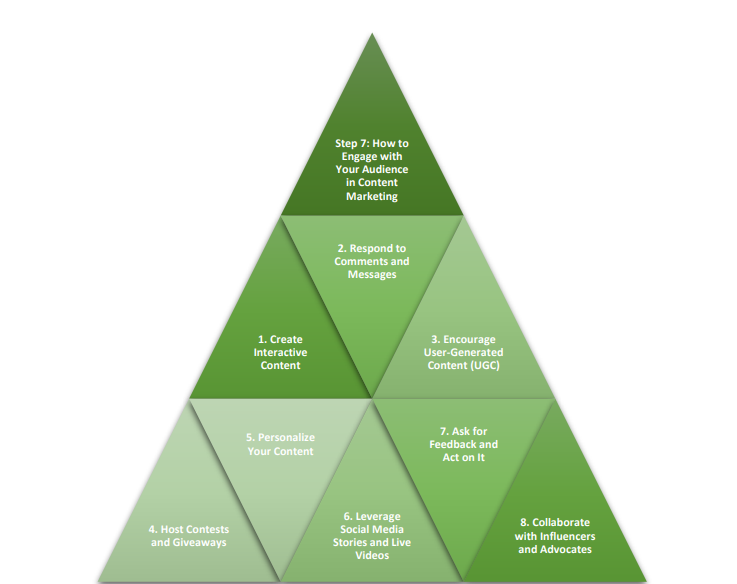
Why Audience Engagement is Crucial
Imagine hosting a party where no one interacts—everyone sits silently, disengaged. That’s what content marketing without audience engagement feels like. Active engagement turns passive viewers into loyal customers and advocates. It fosters trust, encourages dialogue, and strengthens the bond between your brand and its audience.
Strategies to Engage with Your Audience
1. Create Interactive Content
Interactive content captures attention and encourages participation. Examples include:
– Quizzes and polls that address your audience’s interests.
– Interactive infographics that break down complex information.
– Live Q&A sessions on platforms like Instagram, LinkedIn, or Facebook.
Example: A fitness brand could create a quiz titled, “What’s Your Ideal Workout Routine?” to drive engagement while collecting insights about their audience.
2. Respond to Comments and Messages
Timely responses to comments and messages show that you value your audience’s input. Whether it’s a simple “thank you” or a detailed answer to a question, active communication fosters a sense of community.
Pro Tip: At EagleGravity, we recommend setting aside time daily to engage with your audience across all platforms. This consistent interaction builds trust and rapport.
3. Encourage User-Generated Content (UGC)
User-generated content is a powerful way to involve your audience in your brand story. Encourage your followers to:
– Share photos or videos using your products.
– Participate in branded challenges or hashtags.
– Submit testimonials or reviews.
Real-Life Connection: A coffee shop might run a contest encouraging customers to post pictures of their favorite drinks with a unique hashtag. This not only boosts engagement but also creates valuable content for promotion.
4. Host Contests and Giveaways
Everyone loves a chance to win! Contests and giveaways drive immediate engagement and increase visibility. Ensure your entry requirements align with your marketing goals, such as following your page, tagging friends, or sharing your content.
Example: A skincare brand could host a giveaway where participants share their skincare routines using a specific hashtag.
5. Personalize Your Content
Personalization makes your audience feel seen and understood. Use audience data to create tailored content that speaks directly to their needs and interests. Address them by name in emails, recommend products based on past purchases, or segment your audience for targeted campaigns.
6. Leverage Social Media Stories and Live Videos
Stories and live videos create real-time connections with your audience. Share behind-the-scenes content, host live tutorials, or showcase product launches to keep your audience engaged.
Real-Life Connection: Think of a chef doing a live cooking demo, answering questions from viewers in real-time. This creates a dynamic and engaging experience.
7. Ask for Feedback and Act on It
Engagement isn’t just about talking; it’s also about listening. Regularly ask your audience for feedback through surveys, polls, or direct questions in your content. Use their input to refine your strategies and show them that their opinions matter.
8. Collaborate with Influencers and Advocates
Influencers can bridge the gap between your brand and your audience. Partner with influencers who align with your values to create authentic, engaging content that resonates with their followers.
Making Engagement SEO-Friendly
To optimize audience engagement for SEO, use focus keywords like “audience engagement strategies,” “how to engage with your audience,” and “content marketing engagement” within the first 10% of your content. Additionally:
– Use engaging headlines and subheadings.
– Include long-tail keywords relevant to your niche.
– Incorporate calls-to-action (CTAs) that encourage interaction, such as “Share your thoughts in the comments” or “Join the conversation.”
Step 8: How to Monitor Performance in Content Marketing
Monitoring performance is an essential step in content marketing, ensuring that your efforts yield measurable results. At EagleGravity, we emphasize the importance of tracking and analyzing your content’s impact to refine strategies and achieve your goals. Let’s delve into the strategies and tools you need to effectively monitor performance.
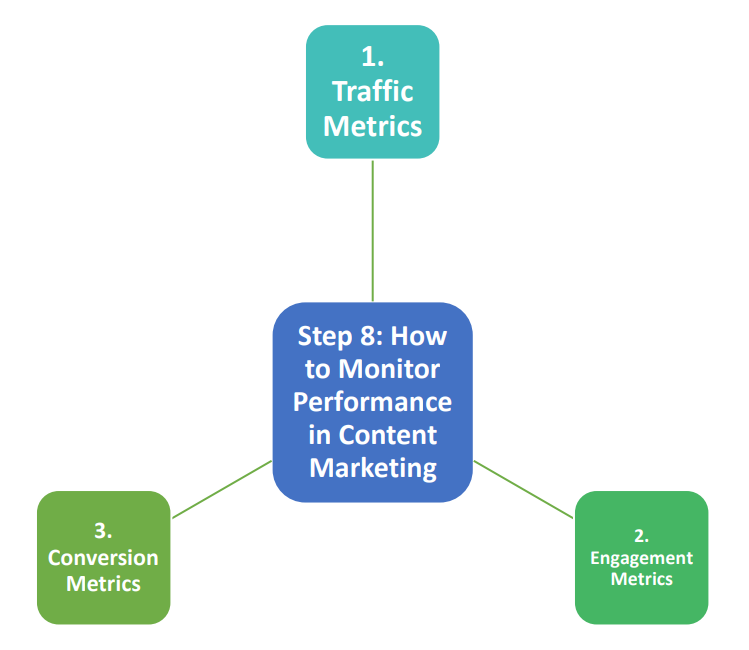
Why Monitoring Performance Matters
Imagine driving a car without a dashboard—you’d have no idea how fast you’re going or how much fuel is left. Similarly, content marketing without performance monitoring leaves you in the dark. Tracking metrics gives you insight into what works, what doesn’t, and how to optimize your content for better results.
Key Metrics to Monitor
1. Traffic Metrics
Understanding where your audience comes from and how they interact with your content is vital. Focus on:
– Pageviews: Total visits to your content.
– Unique Visitors: Individual users visiting your content.
– Traffic Sources: Organic search, social media, referrals, or direct traffic.
Example: A travel blog post on EagleGravity that sees a spike in organic traffic indicates that your SEO efforts are paying off.
2. Engagement Metrics
Engagement metrics reveal how your audience interacts with your content. Monitor:
– Bounce Rate: Percentage of visitors who leave without taking any action.
– Time on Page: Average time spent on your content.
– Social Shares and Comments: Indicators of how compelling and shareable your content is.
3. Conversion Metrics
Conversions track whether your audience takes desired actions, such as:
– Signing up for a newsletter.
– Downloading a resource.
– Making a purchase.
Real-Life Connection: A fitness brand measuring conversions on an eBook landing page can gauge the effectiveness of their call-to-action.
Tools to Monitor Content Performance
1. Google Analytics
This free tool is indispensable for tracking website traffic, user behavior, and conversion rates. Set up goals and funnels to analyze specific user journeys.
2. Social Media Analytics
Platforms like Facebook Insights, Instagram Analytics, and LinkedIn Analytics provide detailed metrics on audience engagement and reach.
3. SEO Tools
Tools like SEMrush, Ahrefs, or Moz help you track keyword rankings, backlinks, and organic search performance.
4. Content Management Systems (CMS)
Most CMS platforms, such as WordPress, offer built-in analytics or plugins to monitor content performance directly.
How to Optimize Content Based on Performance
1. Identify Top-Performing Content
Analyze which pieces of content drive the most traffic, engagement, or conversions. Repurpose or update these to extend their lifecycle.
Example: If a blog post on EagleGravity generates consistent traffic, consider creating a video or infographic based on the same topic.
2. Address Underperforming Content
Identify content with low engagement or high bounce rates. Revise it by:
– Improving headlines and CTAs.
– Adding visuals or interactive elements.
– Optimizing for relevant keywords.
3. A/B Testing
Experiment with different headlines, formats, or CTAs to determine what resonates best with your audience.
Making Performance Monitoring SEO-Friendly
To enhance SEO, use focus keywords like “content performance monitoring,” “content marketing metrics,” and “track content success” within the first 10% of your content. Additionally:
– Optimize meta descriptions and image alt tags for top-performing content.
– Use structured data to improve search visibility.
– Incorporate internal links to related content on EagleGravity.
Step 9: Iterating and Optimizing Content: The Key to Growth with EagleGravity
Creating exceptional content is just the beginning of any successful online journey. To truly thrive, you need to master the art of **iterating and optimizing content**. Whether you’re managing a blog, running an e-commerce store, or building a personal brand, this process is essential for growth. At *EagleGravity*, we understand the transformative power of optimizing content to connect with audiences, improve rankings, and generate impactful results. Here, we’ll delve into the significance of iterating and optimizing your content and how it can resonate with your personal experiences and goals.
What Does It Mean to Iterate and Optimize Content?
Iteration means revisiting and refining your content to make it more engaging, informative, and valuable. This could involve updating outdated statistics, enhancing readability, or adding visuals to improve comprehension. Optimization, on the other hand, focuses on ensuring your content aligns with SEO best practices, including using the right keywords, enhancing metadata, and improving loading speed.
Imagine this: You’ve written a blog post that shares your unique life experience, but it’s not getting the attention it deserves. Through iteration, you’d enhance your storytelling, include examples your audience relates to, and perhaps break long paragraphs into digestible chunks. With optimization, you’d incorporate keywords like “iterate and optimize content” strategically, making it more discoverable on search engines like Google.
Why Iterating and Optimizing Content Matters
In our fast-paced digital world, content that isn’t updated becomes obsolete. Regularly iterating and optimizing content ensures that your hard work stays relevant and impactful. Here are key reasons why this matters:
1. Improved Search Engine Rankings: Search engines prioritize content that is updated and optimized with the right keywords. This increases your visibility and drives more traffic to your site.
2. Enhanced User Experience: Iteration allows you to address gaps in your content, making it more comprehensive and user-friendly.
3. Increased Engagement: By understanding your audience’s pain points and reflecting them in your content, you can create stronger emotional connections.
4. Higher ROI: Optimized content generates more leads, conversions, or sales compared to content left untouched after publication.
Personalizing the Process for You
At EagleGravity, we often hear stories of individuals who pour their hearts into creating content but struggle to see results. Take the example of Sara, a fitness coach, who shared her journey of losing 50 pounds through mindful eating and regular exercise. Her blog post, while inspiring, initially didn’t rank well. Through iteration, she:
– Added detailed meal plans and before-and-after photos.
– Included actionable tips for beginners.
– Shared links to scientific studies supporting her approach.
With optimization, she incorporated keywords like “mindful eating tips” and “fitness journey success” into her headings and meta descriptions. The result? Her post not only ranked higher but also became a trusted resource for her audience.
How to Iterate and Optimize Your Content Effectively
Follow these steps to ensure your content consistently performs well:
1. Analyze Performance Metrics: Use tools like Google Analytics to track bounce rates, time on page, and traffic sources.
2. Identify Keywords: Research trending keywords in your niche and incorporate them naturally into your content.
3. Update Outdated Information: Regularly revisit old posts to ensure accuracy and relevance.
4. Enhance Visual Appeal: Include high-quality images, infographics, and videos to make your content more engaging.
5. Test and Experiment: A/B test headlines, calls-to-action, and layouts to find what resonates most with your audience
Conclusion:
The journey to creating impactful content doesn’t stop at publishing. Iterating and optimizing content is a continuous process that ensures your work remains relevant, engaging, and discoverable. At EagleGravity, we’re here to guide you through this journey, turning your passion into a powerful online presence. Whether it’s refining an old blog post or strategizing for your next viral piece, iterating and optimizing content will transform your digital experience—and your life.
Ready to elevate your content strategy? Let EagleGravity help you soar to new heights!
